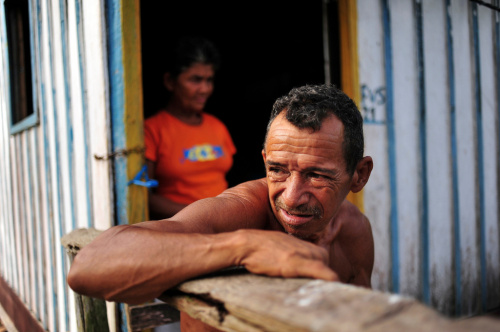LIMA, Peru (10 August, 2012)_Agricultural reform settlements in the Brazilian Amazon have often been associated with high deforestation rates, thus they seem as a natural target for initiatives to reduce emissions from deforestation and degradation (REDD+). However, differences in the deforestation history and levels of economic development among settlements may have important implications for the design of such initiatives, say scientists.
Brazil’s land reform program that aimed to bring “People without land to land without people” has resulted in over 8,500 settlements covering more than 84 million hectares of forest throughout the country.
“Some of these settlements are already engaging in logging arrangements with private companies, through mechanisms that resemble payments for environmental services schemes of the type considered under REDD+,” said Driss Ezzine-de-Blas, researcher at the Centre International en Recherche Agronomique pour le Développement (CIRAD).
However, better off settlements – where deforestation tends to be higher — would reap fewer benefits under realistic REDD+ scenarios than poorer settlements, reducing incentives for them to comply with forest law.
“There are significant differences between settlements with regards to forest cover, deforestation behaviour, settler welfare, plus existing conservation policies, which means that a ‘one size fit’ all approach will not work,” he added.
Land reform settlements represent a critical starting point for REDD+ in Brazil.
Deforestation in land reform settlements is high; 18 percent of deforestation detected by the Brazilian National Space Research Institute from 2002–2006 occurred inside settlement boundaries(usually illegally). REDD — a mechanism which pays forest-rich countries to conserve the carbon stored in trees — could be one way to combat this trend. There are currently over 50 REDD+ pilot projects underway in Brazil.
“REDD+ could help overcome past barriers to sustainable development in settlements, such as precarious infrastructure and the poor quality of public services, including agricultural extension,” said Jan Börner, Professor at the University of Bonn and former CIFOR Research Fellow.
A CIFOR study published last year found that, while deforestation from cattle ranching and land clearing for crops were major causes of deforestation across four studied settlements, deforestation was highest in ‘wealthier’ settlements (those that were able to create sustainable management plans or engage in logging activities). These areas also tended to be the least conserved and many did not adhere to the Brazilian Forest Code that requires the preservation of a minimum amount of forest cover.
Conversely, ‘poorer’ areas tended to be better conserved, as the nutrient-poor soil combined with weak infrastructure and a lack of access to markets, meant that many settlers were unable to benefit financially from the land.
These differences could have huge implications for how REDD+ will be designed in Brazil, argued Ezzine-de-Blas.
For example, settlements with forest cover above legal requirements may receive higher levels of compensation than settlements with forest cover below minimum standards.
“Many settlers with above-average wealth levels would reap fewer benefits from incentive-based REDD+ schemes than poorer settlers, thus reducing incentives for voluntary compliance with forest law,” Ezzine-de-Blas explained.
Despite the challenges, land reform settlements do offer a number a number of opportunities for pilot REDD projects.
“Compared to many areas throughout the Amazon, where property rights are often unclear or conflicting, settlements have well-defined tenure rights which would make REDD+ implementation easier,” Börner said.
The study also found that some settlements already held agreements with commercial loggers. These represent feasible business models for REDD+ schemes, the study concluded, which would see settlers receive regular income in exchange for access to their forests, whilst at the same time encouraging forest cover maintenance.
And what would settlers do with the money they received through an incentive-based REDD+ mechanism? Contrary to widely held beliefs that conservation payments can lead to passivity and increased dependency, the study showed that “settlers who received stumpage fees — the price a logging company pays for the right to harvest timber — showed entrepreneurial spirit and invested these revenues in productive activities.
Incentives however needed to be carefully integrated into the existing management regime of different settlement types. And controlling deforestation moving to areas not covered by conservation agreements may thus represent more of a challenge than alleged cultural barriers to incentive-based conservation, reckons Börner.
“Land reform settlements, nonetheless, represent a critical starting point for incentive-based REDD+ in Brazil,” he added.
Edited by Catriona Moss and Michelle Kovacevic.
This new publication is part of CIFOR’s Global Comparative Study on REDD+ and was supported by the Norwegian Agency for Development Cooperation – Norad, the European Commission (CIRAD) and the French Fund for the World Environment (CIRAD).
We want you to share Forests News content, which is licensed under Creative Commons Attribution-NonCommercial-ShareAlike 4.0 International (CC BY-NC-SA 4.0). This means you are free to redistribute our material for non-commercial purposes. All we ask is that you give Forests News appropriate credit and link to the original Forests News content, indicate if changes were made, and distribute your contributions under the same Creative Commons license. You must notify Forests News if you repost, reprint or reuse our materials by contacting forestsnews@cifor-icraf.org.
